Bleazey Soprano D whistle Review
(Review written February 2006)
- Preface
- As I mentioned in my Swayne review, Bleazey is one of the whistle brands that has been difficult for me to get my hands on to review. I've seen a people talk about them in various mailing lists, but they don't come up for sale that often. I was figuring I'd eventually have to bite the bullet, and put myself on the waiting list. Luckily, a kind benefactor saw that I'd been attempting to trade for one on the Chiff & Fipple mailing list, and offered to loan be his Bleazey and Swayne for review. Thanks again Charlie!
- At a Glance
- Whistle Reviewed
- Bleazey Soprano D whistle
- Models Available
- Whistles in D, C, Bb, A, G, and low D
- How Acquired
- On loan
- Construction
- Wood, metal tuning slide, wood fipple
- Price at Time of Review (in US Dollars unless otherwise noted)
- £110 (approx $195.00 US)
- Available From
-
P.G. Bleazey Woodwinds
- Appearance
- The Bleazey I have to review is boxwood, with brass mounts and a cedar fipple plug. If you look back at my Swayne review as you review the pictures, you can see some of the obvious similarities, such as the thickened and curved bell end of the whistle, the logo placement, and the look of the brass mounts. The tuning slide is a similar length as well. The whistles play completely differently, however.
-
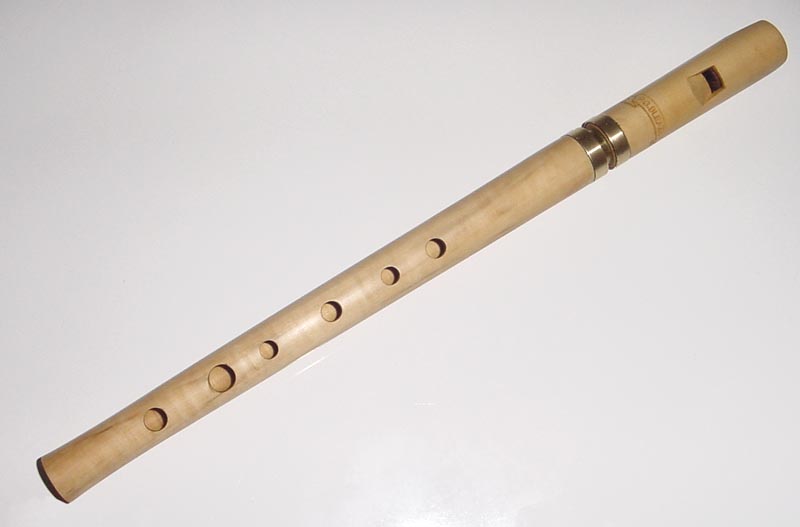
Here's the full whistle. The whistle is boxwood, with brass rings and tuning slide.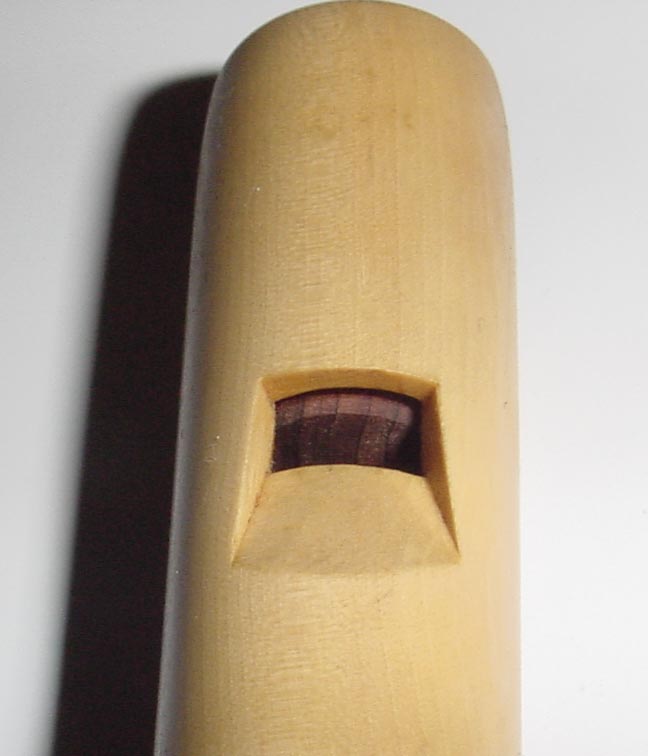
Here's a close-up of the mouthpiece, which is obviously quite different from the Swayne. I like the flared look of the labium ramp.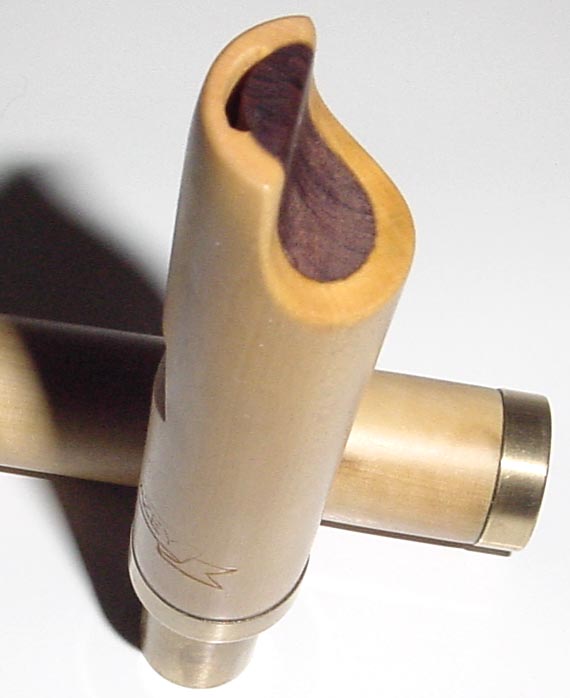
Here's another angle on the mouthpiece, showing the fipple area. The fipple strikes a fine contrast to the boxwood.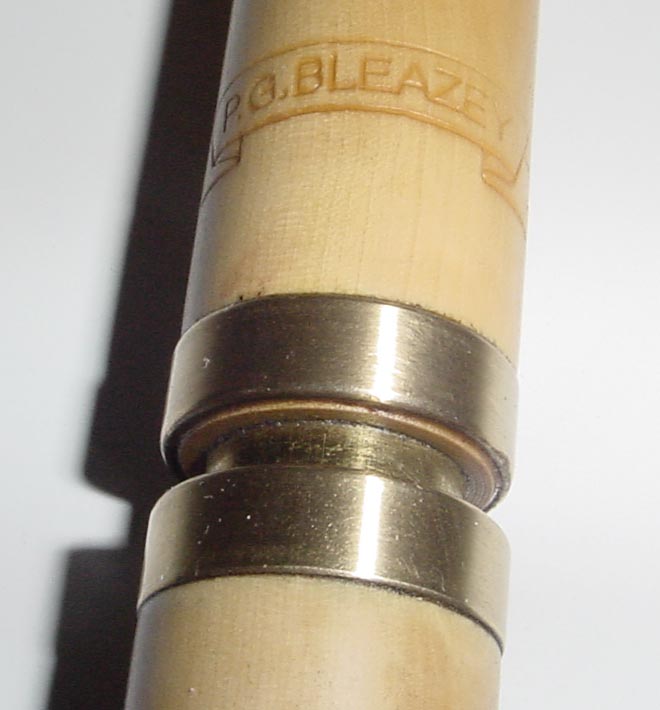
The tuning slide on the Bleazey is slightly longer than on the Swayne or Abell, and you need the extra length. It is easy to move, and holds well when you want it to. You can see the P. G. Bleazey logo here, above the slide.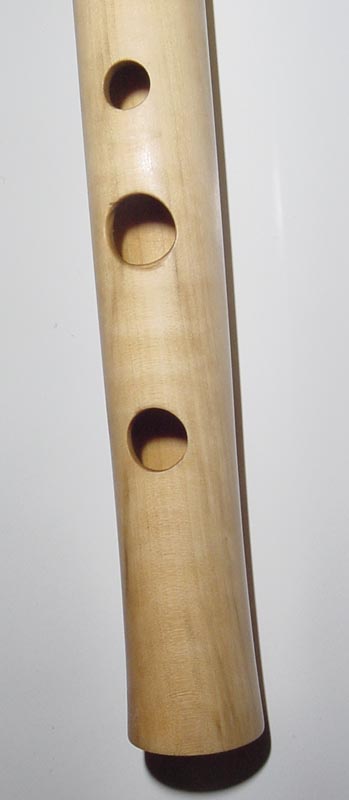
A shot at the end of the whistle, showing the last three holes. I'm also including the bell end of the whistle, so you can see the curvature. I don't think it's as pronounced as on the Swayne. The holes here are a little dark, as if they've been burned. I don't know if this was caused by a high speed drill, or something more purposeful. But it's a neat look.
- Playing Characteristics
- Purer toned, fairly chiff-free whistle. A little weak on the bell note, and requiring some push throughout it's entire range, and a firm attention to breath control. Kind of reminds me of a Susato in tone.
-
Sound clips of the whistle:
Spoot O' SkerryVolume: Strong and loud. Would fits right in with my loud Friday session.
Responsiveness: Fast. I didn't have any issues with this whistle's action.
Tuning: When I first played this whistle, I thought the tuning might be off, but I was under blowing the first octave considerably. I originally was going to review this whistle first, but I decided I needed some extra time to come to grips with this whistle's tuning. once I figured out this whistles breath control, both octaves came into line. The tuning slide has to open a lot more than I expected for this to happen, and you couldn't tune too flat as a result. Unfortunately, the F# is a little flat, no matter how much push I give it, from 5 to 10 cents. You have to back off of the bottom D to bring it into line as well, making it sound a lot weaker than it could otherwise be.
C-natural: Using similar breath control to the B and 2nd octave D, OXXOOO makes a perfect C-natural.
Hole size and placement: The Bleazey holes are average sized, with the E and F# holes slightly closer together. Interestingly, the B and A holes are also close together, leaving the G hole to kind of sit by itself in the middle of the whistle body. I don't think I've seen a hole configuration quite like that one before, but it's a subtle difference. The whistle played comfortably without any extra concentration to keep on the holes.
Air volume requirements: Average. Even with the push described below, you don't use too much extra air. But you don't get nearly as much out of a lungful as you do with the Swayne...it's a solid average.
Air pressure requirements: Higher than expected. What I mean by that is that the first octave plays pretty easily, and sounds nice using the same breath as a Generation or Feadóg. But you'll be underblowing the whistle with that amount of breath pressure, and the whistle will be sharp in the 2nd octave. You have to open the slide up and push a bit in the first octave to get it to jive with the second octave. You have to pay attention to your breath control on this whistle, as there's a bit of a gap between octaves. It can make you want to play the first octave a little too hard, or the second octave a little too soft--either one is detrimental to the tone produced by the whistle.
Clogging: I tended to clog this whistle a bit more than the Swayne. After a bit, the whistle would get a little harsh and unruly, but never quite gave out on me. If it were mine, I'd likely give it the Duponol treatment to keep it from acting up in me in the middle of a performance.
Wind Resistance: Fairly decent. The whistle didn't give out during any of the times that I played it gassing the car up or hanging out in the backyard. As it wasn't especially windy during the review period, I took it out in the garage and pitted it against the big box fan, and it still won. This would likely be a very nice outdoors whistle.
- Summary
- Nice sounding whistle, with a strong tone. The breath control, volume, and stronger push required may intimidate some--and a couple weeks really wasn't enough for me to really get comfortable with the whistle. The F# tuning issue will likely cause a fiddle player with a discerning ear to give you the hairy eyeball if you play in sessions, but isn't so out that it destroys the whistle's sound solo.